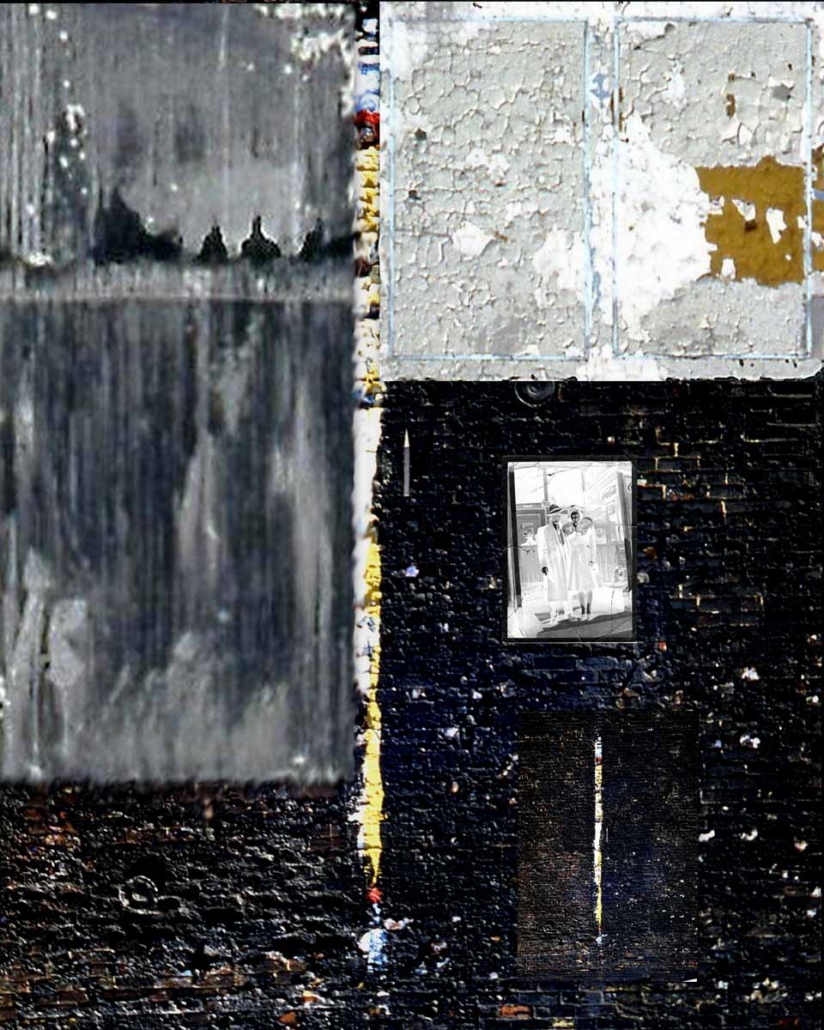Richard Stanford

Abstraction doesn’t always begin with a brushstroke; sometimes, it emerges from a ruin. In Richard Stanford’s work, the weathered textures and fragmented images transform photographs into quiet meditations on memory and erasure.
For years, Richard Stanford explored the hidden stories etched into urban walls—those left bare after neighbouring buildings had collapsed or had been demolished. Weathered by time and the elements, these surfaces became, to him, silent witnesses to lives once lived. He began using them, along with personal photographs, as the foundation for semi-abstract photo collages. Blending fragments of architecture, nature, and memory, his work transforms the every day into visual relics—traces of human presence shaped by light, absence, and time. These collages are where lived experience and abstraction meet. The clock, ever present, marks time without explanation.
In Forest-Fire, Stanford layers willow branches over autumnal reds beneath a calm sky. Hidden among the foliage, a faint face of Jesus from the Holy Shroud emerges like a ghost. The image becomes an oneiric fantasy, where memory blends with landscape. The Gangster’s Wife presents a crumbling urban landscape with a negative of a couple attached to it. The peeling paint and fractured surfaces are not records but expressive wounds. Wednesday Morning offers a sparse nocturnal scene: a silhouette of a lone tree, an illuminated obelisk, and a glowing watch in the foreground. A solitary figure stands on a pedestal, turned away, evoking distance and reflection. The landscape can be interpreted as a psychological space with its entangled symbolism and anxiety towards the transience of things.
Richard’s approach to photo-collage shares affinities with Robert Rauschenberg’s method of layering disparate visual elements to create meaning beyond the literal. Like Rauschenberg’s Combines, which fused found objects, images, and paint into hybrid works, Richard merges fragments of urban decay with personal photographs. Both artists blur the line between documentation and abstraction, transforming everyday materials into complex visual narratives. However, while Rauschenberg often embraced chaos and cultural commentary, Richard’s compositions are more introspective—archaeologies of memory, marked by a quieter, elegiac tone.
Richard Stanford is a photographer, filmmaker and novelist living in Vaudreuil-Dorion, Quebec. He received his degrees from the Université de Montréal and Concordia University. His photography has been exhibited since 2008 at The Montreal Museum of Fine Arts, Vehicule Art Gallery, Arbour Gallery, Skelly Gallery, Workshop Gallery, Cornwall Art Gallery, HUB Centre for the Arts, and Critical Eye Gallery. Ovi Magazine has published two of his photographic exhibitions. He is the author of the scripts and director of 50 documentary films and feature films, with ‘I Wanna Be Me’ from 1984 being his first one. The Adirondack Review, Montage, P.O.V., Canada’s History Magazine and Ovi Magazine published his stories and essays
Richard Stanford is the Bronze Artist of the ArtAscent “Abstraction” call for artists. To see the full body of work and profile, get a copy of the 2025 ArtAscent Art & Literature Journal “Abstraction” issue.




